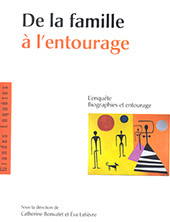De la famille à l’entourage
The Biographies et Entourage survey [Event histories and contact circle]: an assessment 10 years later

De la famille à l’entourage, a recent INED publication, presents a set of studies based on data from the Biographies et Entourage survey [Event histories and contact circle] conducted in 2001 with a representative sample of nearly 3,000 inhabitants of the Ile de France region born between 1930 and 1950. The studies analyse the family, residential and occupational trajectories of men and women of the twentieth century, trajectories that have been resituated in the extended time of generations and the historical context in which they succeeded each other.
An innovative approach to family networks and territories
Describing the reality of the contact circle
With the growing number of separations and stepfamilies, the territory of the family is no longer confined to a single home; the plural family now inhabits a geographical living space of variable size. It is important to explore this space, as it sheds lights on the dynamics of affective ties developed over time. The first contribution of the Biographies et Entourage survey was to identify, measure and empirically describe individuals’ entourages [contact circles]. The world of the family and chosen affinities encompasses a much more complex reality than the restricted family, a reality whose contours may vary by whether they are limited to family ties or extended to other close contacts. This world is one of emotional and residential closeness and is characterized by mutual aid networks of varying intensity that may or may not be sought out and may indeed be avoided or reactivated depending on the events affecting its members.
Studying residential mobility and the family territory
The survey also made it possible to describe the urban revolution that France has undergone in the last fifty years, particularly in the Ile de France region, which has been transformed by profound urban changes, including renovation of the national capital, densification of Paris suburbs, and the phenomenon of peri-urbanisation or urban sprawl. The residential history of the 1930-1950 generations is quite particular, unfolding as it has in the transition or border area between two worlds: the rural society of the early twentieth century that these individuals experienced in their childhood, and the ultramodern society of the twenty-first century that they helped to build. In this context of profound change, the survey contributed new material on the rootedness of Ile de France residents and mechanisms of a family or occupational nature operative in migrant settlement. But whether the process was one of mobility, settlement or the realizing of retirement plans, the survey also revealed the fundamental role of the contact circle
Ambitious methodological objectives
The shift from collecting individual event histories to collecting event histories of entire contact circles required combining the flexibility of qualitative interviewing with the rigour of quantitative measurement. It was necessary to systematize the reconstitution of respondents’ relational networks over time and integrate event history material that is usually collected through qualitative interviews into a quantitative questionnaire format. Collecting the interactive event histories of the members of a given individual’s contact circle throughout that individual’s life made it possible to explore several methods of trajectory analysis (including Optimal Matching), to construct living space typologies and to study occupational careers. For the first time, it was possible to do longitudinal analysis of exchanges between the various members of an individual’s contact circle, notably exchanges in the form of intergenerational solidarity or social transmission, in connection with contexts of opportunity or determinant factors of continuity or downward social mobility.
Lastly, because the survey makes it possible to analyse
perception variables applied to entire trajectories, it allowed for
advancing into a new field: comparing facts from the different
event histories with the meaning that individuals attribute to them
in the course of their lives uncovers a wealth of material for
interpreting breaks and turning points in life paths. In sum, the
book presents a variety of promising analytic approaches and
constitutes a useful tool for researchers wishing to do event
history surveys and develop new research studies in the social
sciences.
Source: Catherine Bonvalet, Eva Lelièvre, 2012, De la famille à l’entourage, Ined, Collection : Grandes Enquêtes, 472 pages
Contact: Catherine Bonvalet, Eva Lelièvre
Online: October 2012
